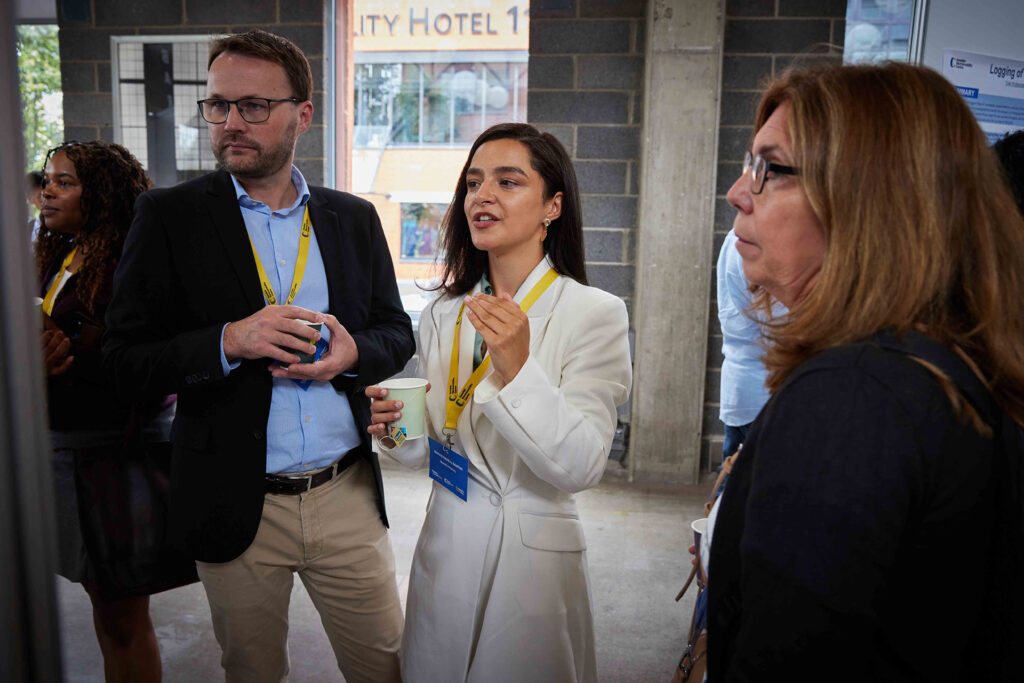
As the number of electric vehicles increases, it puts more pressure on the power grid. Smart charging is a concept that can take the load off the grid during peak hours. Marina Mattos, PhD student at Uppsala University, is developing and testing different smart charging strategies in Dansmästaren, a multifunctional building in Uppsala.
Marina Mattos comes from Juiz de fora, a historic city in Brazil known for its university. It is located in the mountains of Minas Gerais, north of Rio de Janeiro state. She has bachelor’s degree in electrical engineering with emphasis on power systems, and my master’s degree was in electrical engineering with emphasis on energy focus on electromobility and renewable energies.
“I have always wanted to live abroad and when I saw this PhD position in Uppsala, that the subject was very similar to my master’s, I decided to apply for it. I like Sweden. It’s very organized, and you have come far ahead in women’s equality. Sweden and Brazil are very much opposites but there are similarities too, like the “fika” culture that we also share, especially in my home state, where I was born and raised,” says Marina Mattos.

Dansmästaren – a unique test bed
Dansmästaren is a multifunctional building in Uppsala comprising a parking garage with 60 charging stations, student apartments, and a supermarket. It is also equipped with a battery energy storage system (BESS) and photovoltaic panels. Serving as a research test bed, it incorporates an Energy Management System (EMS) that enables the implementation of smart charging strategies and the collection of real-world data.
“It has the unique characteristic of suppling for both public EV users and residential EV owners, with three floors designated for residential use and two floors for public access. It is worth noting that the Uppsala municipality plans to construct additional multifunctional buildings, allowing the impact of the designed strategies to be scaled and become more significant,” says Marina Mattos.
What is your research about, Marina?
“My research is focused on smart charging strategies for smart cities. I develop new strategies for implementation in the parking garage at Dansmästaren, currently emphasizing Vehicle-one-Grid (V1G) technology, with plans to extend to Vehicle-to-Grid (V2G) in the future. All designed strategies are first tested on the Research Twin, a free charging station located at Ångströmlaboratoriet, before being applied to the chargers at the parking garage. Additionally, I study electric vehicle user behavior and usage patterns to better understand stakeholder needs and identify ways to alleviate grid congestion.

What’s the difference between smart and dumb charging?
“Haha, ‘dumb charging’ basically refers to when a user plugs in their vehicle and it begins charging immediately, drawing the current determined by the car based on the charger’s available capacity. For example, each outlet in Dansmästaren allows electric vehicles to charge at up to 32 A, and the car decides the actual current to draw, up to that maximum. With smart charging, however, the maximum current supplied to the EV is controlled and can be adjusted based on factors such as energy prices, forecasts, or other considerations.”
Why do we need smart charging?
“Government policies in several countries have been developed to decarbonize both the power generation and transport sectors. Electromobility is growing rapidly, and the existing grid is not fully prepared to handle the additional load from widespread EV charging. Rather than investing in costly expansions of the distribution grid, a more environmentally sustainable solution is to use existing resources intelligently. Smart charging strategies are designed to alleviate grid congestion while also providing environmental benefits. The main objective is to control EV charging in a way that prevents it from adding to peak demand on the grid.”
How effective are the smart charging strategies implemented?
“During the winter of 2024, we implemented a Spot Price control strategy at Dansmästaren for nearly two months, covering January and February. The results were very positive: the strategy alleviated the stress on the building’s Battery Energy Storage System (BESS), which normally must supply building demand in addition to the grid during peak hours in winter. This demonstrates that the designed strategies are working as intended, making better use of existing resources to relieve the grid. The effect becomes even more significant when considering multiple multifunctional buildings operating together in a smart grid, as planned for Uppsala´s municipality. Uppsala Parkering, with whom we collaborated on implementing these smart charging strategies at the parking garage, has been very happy with the results.”
Does smart charging affect the end user?
“I’m not aware of any complaints with the tests in this project. The adjustments in charging time have probably not been noticeable for the users in any significant way, even for those using the public chargers. The smart charging strategies are always simulated before implementation, and the tests are communicated via an app at the parking garage. User needs and perception are taken very seriously by everyone in the project, and it’s discussed regularly in our meetings between academia and industry.”
Is it something you would like to add?
“Yes, I would like to add that I am very grateful to be involved in this project and in the collaboration between the university and its industrial partners. I would like to thank you, Volvo Cars, Zeekr Tech, Uppsala Parkering, E-ON, Vattenfall, Charge Amps, STUNS, and Uppsala Kommun for all the contributions with different views to find the best solutions together. And also, to thank you my project group, principally Valeria Castellucci and Alexander Wallberg for all the learning and support. Being part of this project has been a rewarding experience both professionally and personally.”
Seminar presentation
SEC theme Vehicle-Grid Interaction arranges a seminar 21 Oct, where Marina Mattos will present her licentiate thesis. For more information: https://emobilitycentre.se/event/theme-5-vehicle-grid-interaction-electric-vehicles-smart-charging-strategies-in-buildings-half-time-seminar-presentation
The licentiate seminar defence is planned for 24 Oct.
Contact:
Marina Mattos: https://www.uu.se/kontakt-och-organisation/personal?query=N23-775